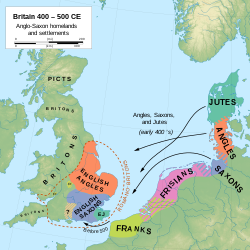| Icel | |
|---|---|
| King of Mercia | |
| Reign | c. 515 – c. 535 |
| Predecessor | Title established |
| Successor | Cnebba |
| Born | before 489 (possibly 460) Denmark or Germany |
| Died | c. 535 Mercia |
| Issue | Cnebba |
| House | Angles, Icelingas |
| Father | Eomer |
Icel (c. 460 – c. 535), also spelt Icil, is a possible king of Mercia. He was supposedly the son of Eomer (443–489), last King of the Angles in Angeln. Icel supposedly led his people across the North Sea to Britain around 515 during the Anglo-Saxon settlement of Britain.[1] Icel was the eponymous ancestor of his grandfather's family, the Iclingas.
History[edit]

Icel was born before 489, probably around 460. He became king of Anglia upon his father's death in 489. He was the last king of Anglia, migrating to England around 515. During the same year, he became king of Mercia.[2]
By 527, Icel had worked his way through East Anglia and into Mercia, as it has been reported in the 13th century manuscript known as the Flores Historiarum: “Pagans came from Germany and occupied East Anglia, that is, the country of the East Angles; and some of them invaded Mercia, and waged war against the British.” By his death c. 535, it is reported that Icel held large portions of both East Anglia and Mercia, and therefore could be considered the first true king of Mercia.[2] Icel was succeeded by Cnebba shortly after his death.
References[edit]
- ^ Michael James Swanton (1998). An Anglo-Saxon Chronicle. Psychology Press. pp. 24 & 338. ISBN 978-0-415-92129-9. Retrieved 3 December 2012.
- ^ a b "Kings and Queens of Mercia (515–819)". Historic UK. Retrieved 19 July 2020.

Well, that’s interesting to know that Psilotum nudum are known as whisk ferns. Psilotum nudum is the commoner species of the two. While the P. flaccidum is a rare species and is found in the tropical islands. Both the species are usually epiphytic in habit and grow upon tree ferns. These species may also be terrestrial and grow in humus or in the crevices of the rocks.
View the detailed Guide of Psilotum nudum: Detailed Study Of Psilotum Nudum (Whisk Fern), Classification, Anatomy, Reproduction